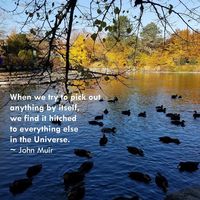Now in its seventh year, the annual gathering of Living Building Challenge project teams and their kin—known as Living Future—has really hit its stride.
 Reinventing the materials supply chain is not for the faint-of-heart!Photo Credit: Eden Brukman, ILFI
Reinventing the materials supply chain is not for the faint-of-heart!Photo Credit: Eden Brukman, ILFI
The annual Living Future event rotates between Vancouver, Seattle, and Portland, the three hubs of Cascadia Green Building Council, which is a chapter of both the U.S. and Canada Green Building Councils and a program within the relatively new International Living Future Institute (ILFI). (Jason McLennan, CEO of the Cascadia GBC and ILFI, is not one to follow the rules, and his organizations routinely flout the policies of their parent organizations.)
The “un-conference”
In line with that anarchistic theme, Living Future is not a “conference,”—it’s an “un-conference,” which is both a narcissistic gesture (we’re too cool to like conferences) and a welcome invitation to explore alternative formats for sessions, meals, and parties. In food-truck-happy Portland, for example, instead of serving us lunch in the hotel, Living Future gave everyone coupons for lunch at one of the dozens of nearby food carts.
They even took advantage of Portland’s innovative GoBox service to eliminate disposable containers. The inconvenience of having to go out and get lunch was offset by the treat of getting outside and engaging with the local (off-beat) culture.
The theme this year was “Women Changing the World,” and the conference did a nice job of exploring feminist perspectives without making (most of) the men feel threatened. Opening Keynote speaker Dr. Vandana Shiva set the stage well, challenging the global institutional view that subsistence agriculture doesn’t count as productive economic activity. Kira Gould posted a great summary of her talk.
The year’s main event for some firms
The sell-out crowd of 1,000 “delegates” (I find that label unfortunately political) included many green building luminaries and entire contingents from several firms that are engaged with Living Building Challenge projects and have chosen to convene their sustainable design teams during this event. Perkins + Will, for example, brought 40 people, and Turner Construction brought 20.
SmithGroupJJR is now designing a Living Building for Chesapeake Bay Foundation, a dozen years after the firm created a pioneering LEED building for that organization. In support of that project, SmithGroupJJR showed up with their client and ten staff members. An enthusiastic architect from another large firm, attending Living Future for the first time, said that she planned on telling her colleagues that this should be their go-to event as well.
Reinventing the materials supply chain
Following up on a session we did last year on toxicity in building materials, I participated with many of the same people this year to convene a conversation about how to reinvent the materials supply chain. We didn’t entirely solve that design problem, but some great insights emerged; stay tuned for a follow-up post after the intrepid ILFI VP Eden Brukman gets a break from her travels and shares the notes she collected.
Talkin’ ‘bout regeneration
Regenerative design in its various guises was featured as well. At last year’s Living Future, that topic seemed at times to be competing with the Living Building framework championed by ILFI. The organizers addressed that tension this year by expanding the tent and inviting consultant and author Carol Sanford as a keynote speaker. Sanford is a mentor, through the Regenesis Group, to consultant Bill Reed and has informed his “starting from the whole” approach to regenerative design.
Noting that ILFI is launching a Living Future Accreditation program for professionals, she issued a strong challenge to ILFI and, in fact, to the entire green building community about the damage caused by structured frameworks and external reward systems. You’d have to read her latest book to get the full picture, but the main point seems to be that holistic solutions can only come from striving to help a person or organization achieve its highest potential, a pursuit that requires radical openness, not simple-minded pursuit of preset goals.
This challenge notwithstanding, Jason McLennan announced the theme of Resilience and Regeneration for next year’s Living Future in Seattle. The conference will be strictly limited to 1,000, he says, so register soon or risk being left out!




Add new comment
To post a comment, you need to register for a BuildingGreen Basic membership (free) or login to your existing profile.